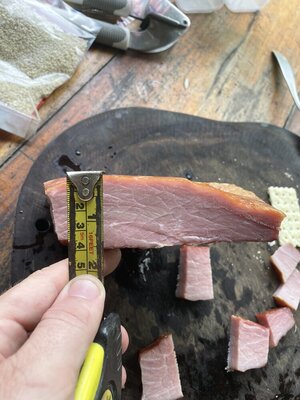- Oct 19, 2020
- 20
- 22
Hi all.
I took a fresh ham and seperated all individual muscles. Then I EQ cured them (2.5% salt 0.25% cure 1) for 12 day. After which I dried it in my ref for 24 hours to be finished smoking at 160-170 until int temp was 145.
If you look at the picture, there is still a grey spot. Isn’t 12 days enough for 1.5”??? I would think it must be, So what am I doing wrong? Pls advise. Thx in advance
I took a fresh ham and seperated all individual muscles. Then I EQ cured them (2.5% salt 0.25% cure 1) for 12 day. After which I dried it in my ref for 24 hours to be finished smoking at 160-170 until int temp was 145.
If you look at the picture, there is still a grey spot. Isn’t 12 days enough for 1.5”??? I would think it must be, So what am I doing wrong? Pls advise. Thx in advance







